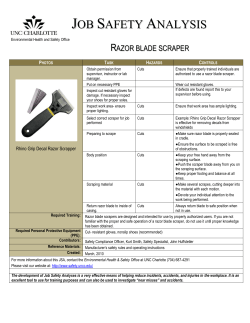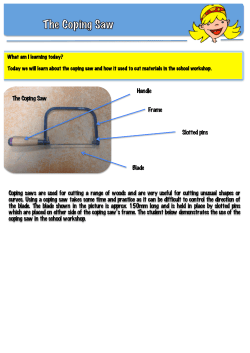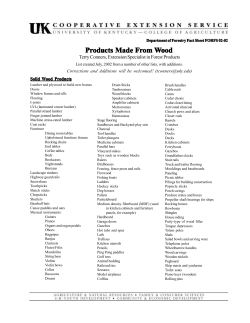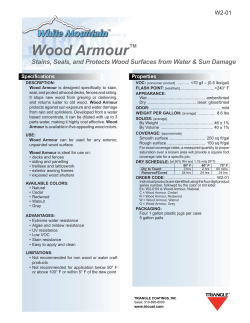
Whittling a Three-Link Chain An Olde Tyme Whittlin’ Project
Whittling a Three-Link Chain An Olde Tyme Whittlin’ Project “Handcarved folk art from the heart of the Blue Ridge Mountains.” Forward Comments/Corrections/Best Practices to: Mountain Star Studio 1329 West Main Street – Studio `107 Salem, Virginia 24153 MTN-STAR@juno.com http://members.tripod.com/MTN_STAR http://members.tripod.com/TheCarvingBench ó ó ó Revision History Created: January 20000 Revised: February 2000 Contents Contents ............................................................................................................................................................1 Introduction ..................................................................................................................................................3 Materials and Supplies ...........................................................................................................................3 Tools ............................................................................................................................................................3 Supplies .....................................................................................................................................................4 Layout.................................................................................................................................................................4 Rough-Out.......................................................................................................................................................5 Clean-Up ...........................................................................................................................................................9 Finishing............................................................................................................................................................9 Summary...........................................................................................................................................................9 NOTES ............................................................................................................................................................10 Patterns and Variations ....................................................................................................................... 11 Circular Links.......................................................................................................................................13 Endless Chain.......................................................................................................................................14 Chain and Ball-n-Box .......................................................................................................................15 Resources ......................................................................................................................................................17 1 2 Introduction One of the most interesting of the old time whittling projects is the making of a chain. This project has been around for along time. Although the chain is not considered a piece of fine wood sculpture, none-the-less it does show the skill of the whittling art. Chains have been created that are hundreds of feet long. Telephone poles have been chain sawn into chains. Toothpicks have been surgically incised into chains. No toothpicks or hundred-link chains in this project! This project shows how to carve only three links of a chain. Repeating the pattern on a longer piece of wood can make a longer chain. After learning the basics, a longer and more elaborate chain can be whittled. This guide introduces the carver to the basics, including: • Materials and supplies • • • • Layout Roughout Cleanup Finish Materials and Supplies This project is easy on the wallet, as only a few items are needed to complete it. Tools Gather the following tools: • A sharp knife • A ruler • A pencil • • • • A strop Finger protection (glove or fingers) Saw to cut the block. See ”Layout” on page 4. Optional: a craft (EXACTO™) knife 3 Supplies Gather the following supplies: • Medium sandpaper • Quick dry lacquer • A 1¼” x 1¼” x 4” block of basswood or pine Layout The three-link chain is whittled from a block of basswood or white pine, measuring 1¼” x 1¼” x 4”, as shown below. The Block Do not be afraid to experiment with other woods. This project does not require the wood to hold detail. Measure and mark the block. Cut to the specifications. Mark the dimensions on all sides of the block as shown below. Block Measurements See HINT 1 for a shortcut. 4 Shade the areas as indicated in the sketch below. Wood Removal Rough-Out The shaded areas represent the wood that must be removed from the block. This removal forms a three-dimensional plus (+) sign. Shave away the four-corners until the block looks somewhat like the one shown in the sketch below. Shaving the Corners HINT–1 Rather than carving your fingers to the bone, set your table saw to cut a ¼” x ¼” dado on each corner. You may consider this a breach of whittling etiquette, but think of the guy using the chainsaw on the telephone pole! 5 Run the knife blade down the lines as shown in the sketch below. Do not force the blade too deep. Carefully cut slivers of wood away, a few at a time. Continue until all the shaded area is completely removed. Removing the Shaded Areas Take your time. Use short, slow knife strokes. NOTE Be aware of the grain dynamics. If the blade is cutting against the grain, it will take large “chunks” of wood. When this happens, reverse the direction of the knife. When one corner is done, go to the next corner. Continue until your block of wood looks like a long cross, or three-dimensional plus symbol (+). The Roughed-Out Block Draw the outline of the chain links on this shape. Transfer the measurements of the patterns to the wood. Use the measurements as shown on the fullsized pattern on page 12. 6 Double-check your block’s layout by comparing it to the sketch below. Link Lay-Out Whittle out the shaded areas as shown above. Use controlled strokes. The links should now be taking shape as shown in the sketch below. Shaded Areas Removed—Links Blocked-In Continue whittling by carving the inside of the links by following the pencil marks as shown above. Make stop cuts inside each link. Widen these stop cuts by angling the blade to both sides of your first cut. If you are lining up these cuts on both sides correctly, the knife will cut through. From this point, the block becomes much more delicate. Make light cuts with a sharp blade to ensure both the chain and your fingers remain unscathed. Once you have carved through the inside of a link, you will be able to complete the separation between two links. Continue making tiny stop cuts from either side until you have cut through. 7 Separate the links now. The areas marked with an “X” are to be carefully removed as shown in the sketch below. Separating the Links The links are still joined at their ends. Be sure that you know what wood goes with which link. Take a pencil and draw as much of each link on the block as you can. You need to cut through these ends without damaging the links. To accomplish this, make sure you have a sharp, pointed blade. There will not be enough room to get a fat, curved blade into this tiny space. Take tiny cuts from all angles until you break through. Do not make any attempt to shape or clean up the links until they have broken free from one another. Try to cut a few links free before moving on to new ones. Pay attention to the grain direction as you cut. The wood is very weak at these points and requires very delicate cuts. Clean up the ends of each link before going on to the sides. Because the sides are lined up with the grain, they are much easier to round off. Continue carving any remaining links until the block is completely transformed into a chain. 8 HINT–2 Use a thin-bladed, long-tipped craft knife to “slice” the links apart. This requires cutting “across” the grain. Take your time. Clean-Up Once the links are free, start rounding them until they are smooth. Use short, paring strokes for this detail work. Try to remove all fuzzies and picks. Be aware of the grain dynamics. See “Separate the Links” above for more information. Sand lightly if you wish to complete the round up. Using a soft brush (toothbrush), scrub the project with a mild dish detergent. This removes the oils and acids acquired from your hands. Let it dry. Finishing This project does not require finishing. It could be stained or painted with a thin wash of acrylics if desired. This project will be handled by all that admire your handiwork. Several coats of a quick drying lacquer will protect your project from dust and fingerprints. Summary You have completed your three-link chain. Congratulations! You may now move up the “chain” of whittling to the next level! By repeating the procedures and patterns used in this project, you can make any length of chain you wish. Change the dimensions proportionally to make smaller or larger links. You have mastered the fundamentals. If your confidence lags, repeat this project until you feel comfortable. The “Patterns” section offers additional chain projects. 9 NOTES 10 Patterns and Variations This section contains patterns and variations for other chain link projects. • Full-sized three-link • Circular links • Endless chain • Chain and ball-n-box 11 TOP VIEW SIDE VIEW Full-Sized Pattern for a Three-Link Chain 12 Circular Links In place of the popular design used in the project above, make your chain links different. The circular links illustrated below are one variation. The method of laying out a pattern and of whittling the links are the same. The dimensions will change. One-half Size Illustration of a Circular Link Draw your pattern on paper, similar to the sketch above. Use your own dimensions or use the measurements on the preceding page. When your pattern is finished, transfer it to a suitably sized block of wood. 13 Endless Chain Instead of the straight length of chain, you can make a continuous or endless chain. You will need a wider board for this project than is required for a straight chain. The links on the end will be fragile because the grain of the wood runs across the entire link and a little more care will have to be used to keep them from breaking off. 14 Only a general layout is provided in the sketch above. You may desire to change the size of the finished chain. Adjust the dimensions to suit yourself. Use the “three-link” proportions as reference. You can include as many links as you wish in the length, but do not exceed the three shown in the width of the board. Chain and Ball-n-Box If you intend to attach a chain to a ball-n-box or to a handle, allow an increase in the length dimension to create a fixed linked, or half link, as shown below. Attaching a Chain A chain can be "attached" to any carving. The carving must have a loop to which to attach the first chain link. 15 NOTES 16 Resources For books, tools, and supplies, visit one of these carving supplies: Smoky Mountain Woodcarvers Supply, Inc. POB 82 Townsend, TN 37882 Orders: 1-800-541-5994 Mountain Heritage Crafters 601 Quail Drive Bluefield, Virginia 24605 Order: 1-800-643-0995 Little Mountain Supply, Inc. Route 2, Box 1329 Bowling Green Road Front Royal, Virginia 22630 Orders: 1-800-752-757 17
© Copyright 2025





















